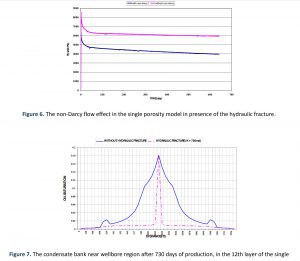SIMULATING THE EFFECT OF NON-DARCY FLOW AND HYDRAULIC FRACTURING ON WELL PRODUCTIVITY IN A NATURALLY FRACTURELEAN GAS CONDENSATE RESERVOIR
ABSTRACT
Condensate formation near the wellbore area of gas condensate reservoirs, below the fluid dew point, reduces the gas relative permeability and, consequently, decreases the well productivity. Alternative solutions including drilling horizontal wells, hydraulic fracturing in vertical wells, gas recycling, and increasing production rate can prevent the reduction of productivity. Hydraulic fracturing has been introduced as one of the frequently-used methods to enhance the productivity in gas wells. The main goal of this study is to numerically simulate the effect of hydraulic fracturing and non-Darcy flow on well productivity of an Iranian gas condensate naturally fractured reservoir by the CMG-GEM, which is a commercial simulator. The studied reservoir is of ‘lean gas condensate’ type at which the condensed volume is at most 1% of the total volume. The studied reservoir was modelled in two approaches. In the first model, the reservoir includes a network of natural fractures modelled by dual porosity approach; while, in the second model, single porosity method was used to model the reservoir. Both models were run in the existence of hydraulic fractures and without them. The outputs showed that hydraulic fractures did not affect the productivity index in the dual porosity model; however, such fractures increased the productivity index of the single porosity model. In the next step, non-Darcy flow conditions were added to the previous runs. Presence of the non-Darcy flow decreased the productivity index where the productivity reduction was substantial in the dual porosity model.
KEYWORDS
gas condensate; hydraulic fracture; non-Darcy flow; productivity index


